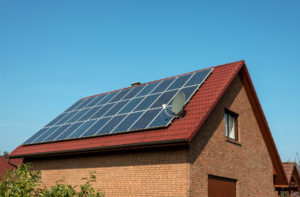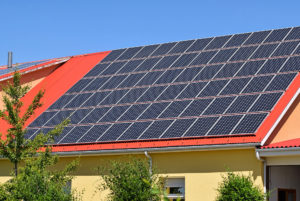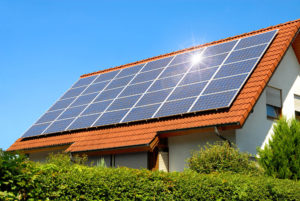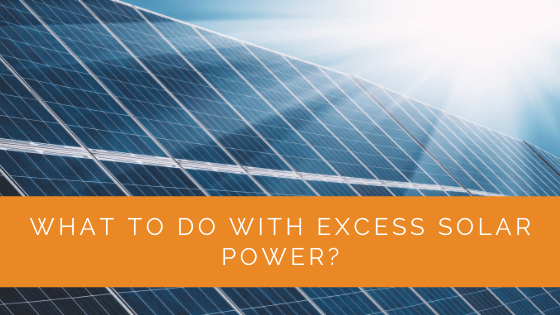You must have read numerous articles explaining the benefits of renewable energy sources. As a result, you must also have installed solar panels to meet your energy demand.
However, using solar technology isn’t always straightforward. You can miscalculate your power consumption or install a PV system with more energy output.
Irrespective of the reasons, a higher capacity solar system can put you in a slight quandary. What should I do with this surplus energy?
Along with lucrative federal tax credits, you can use options like net metering or load management. This article explains how to utilize excess solar energy and gain quantifiable benefits.
Contents
- 1 Key Takeaways
- 2 Reasons Solar Panels Produce Excess Energy
- 3 Use Of Net Metering
- 4 A Quick Look At Solar System Types
- 5 How Does Excess Solar Power Reach The Grid?
- 6 Use Of Battery Banks
- 7 Use Of Load Management
- 8 Frequently Asked Questions
- 9 Case Study: Effective Utilization of Excess Solar Power in New Hampshire
- 10 Expert Insights From Our Solar Panel Installers About What To Do With Excess Solar Power
- 11 Experience Solar Excellence with Us!
- 12 Wrapping Up
Key Takeaways
- Excess solar power can occur due to factors like seasonal variations, low energy consumption, or the installation of a high-capacity PV system.
- To make the most of excess solar energy, you can utilize options like net metering, which allows you to earn credits by selling surplus energy to the electric utility company.
- Other strategies include using battery banks to store excess energy for later use and load management, where you prioritize heavy power consumption during periods of surplus solar power.
Reasons Solar Panels Produce Excess Energy
Excess solar power generation can result from some technical and uncontrollable factors. Hence, you should know why your PV systems produce excess power.
Here are some practical reasons why solar panels produce extra energy.
- The season can have an impact on solar panels efficiency
- Your electrical consumption is low
- You installed a high-capacity system than required
Seasonal Effect
Solar generation is high during summers. PV solar modules receive intense sunlight, thereby producing excess energy.
On the contrary, these systems use power from the grid during the overcast or winter season. So, if you observe this pattern, it is mainly an uncontrollable factor.
Low Energy Consumption
Unoccupied commercial or residential buildings equipped with a solar system utilize less energy. In some cases, a decline in the number of occupants leads to less demand for electricity.
These reasons can lead to the production of excess solar electricity. To rectify this scenario, you need to increase energy consumption.

Installation Of High-capacity PV System
Call it insufficient research or investment for the future; some residents install solar power systems with extra capacity.
In such a case, you end up underutilizing the extra power. So, you are left with more electricity than required.
Use Of Net Metering
The direct solution to utilize extra solar energy is net metering. This concept offers solar energy consumers a channel to earn credits by selling excess energy.
You can forward excess solar power to the electric utility company. In order to avail of this facility, you should keep the following points in mind.
- Grid-tied model
- Bi-directional meter
Note that an off-grid solar system cannot avail of this benefit as it is not tied to an electric utility site.
A Quick Look At Solar System Types
There are three kinds of solar systems. You can produce excess solar power output in all three types.
- On-grid system
- Off-grid system
- Hybrid system
An on-grid system works in tandem with the utility grid. In simple words, your solar panels produce electricity. However, in case of less sunlight, you can use the electric power from the grid.
This system is popular due to its apparent benefits.
Off-grid solar systems work without the requirement of an electric utility grid. They generally have battery banks to store excess solar power generated by the panels.
These systems are self-sufficient and useful in industrial buildings or residential spaces located remotely.
Finally, hybrid systems are a combination of the above two types. It is connected to the grid and contains a battery bank for sustaining. You can forward the surplus energy to the power company.
How Does Excess Solar Power Reach The Grid?
It is clear that you need to be connected to the power grid to send excess power. Using net metering, solar consumers can earn credits. However, this concept varies in different American states.
When your installed system produces excess solar energy, the meter connected with the grid runs in reverse.
In simple words, the meter sends your surplus power back to the grid. Eventually, you receive credits on your electricity bills.
This credit calculation takes place by considering kWh energy sent to the grid. You should first check the credit policies according to the state of residence.
Use Of Battery Banks
In the case of off-grid systems, excess energy production can seem difficult to manage. After all, you cannot use a bi-directional power meter to send electricity back to the grid.
However, you have the option to store this electricity in batteries. You should begin by calculating the investment of a storage system.
If the cost fits your budget, you can benefit from a storage capacity unit.
In most cases, lead-acid batteries or any storage units are optional. But, in the case of off-grid systems, they make the perfect asset.

Benefits Of Battery Storage
A solar battery proves advantageous from operating the water heater to balancing the electrical load. In addition to the utility-oriented benefits, batteries can store excess solar power.
The benefit? You can use this electricity to operate appliances in case of a major power breakdown. Furthermore, batteries are one of the best power sources during the winter and rainy seasons.
Overall, you will always end up with enough energy if you store the extra electricity in a solar battery.
Use Of Load Management
Load management is the third practical way to deal with additional solar power. This method implies distributing or managing heavy loads during excess solar power output periods.
You use power from a solar system to operate other heavy applications in simple terms.
- Water heating
- Electric vehicles charging
- HVAC system operation
Also known as load shift, you utilize heavy-duty applications during the day when solar panels produce surplus power.
On the contrary, you do not use gadgets like an air conditioner or charge the electric vehicle at night. This strategy is an intelligent way to make the optimum use of excess solar energy.
Frequently Asked Questions
Some questions regarding energy production are common amongst solar users. This section covers the most frequent queries.
Do you get paid for excess solar?
Different states have laws and credit policies for users who produce extra solar energy. Net metering is ideal for sending such surplus solar energy back to the utility grid.
You receive credits on your utility bills depending on the state laws. However, you do not receive cash or cheque payments from the local utility grid.
So, solar consumers do not get paid directly for sending excess solar energy in a grid-tied or hybrid system.
Can someone overload the solar system?
A solar charge controller regulates the power flowing from panels to the storage units known as batteries.
Hence, a system with a charge controller, fuses, and circuit breakers prevents the overloading of solar batteries and the system.
Overall, with the right equipment in place, the chances of ‘overload’ are low.
What is the solar tax credit concept?
The Federal Investment Tax Credit is also known as the solar tax credit. This credit is a US government initiative to encourage residents to install solar panel systems.
After installation, users can deduct 30% of the solar energy system cost from their federal tax between 2022 and 2032. This is an increase from the previously planned tax credit rates. Starting from 2033, the tax credit will decrease, decreasing to 26% in 2033 and further reducing to 22% in 2034.
What are California’s net metering rules?
According to the state laws, if you own a solar system below 1,000 kW, you can avail of bill credits in California.
This rule applies to both residential and commercial solar users. You receive a credit of one kWh of utility electricity in return for the same amount of excess solar power sent to the grid.
Hence, California has a simple net metering policy that encourages and benefits solar energy users. You should always check such local state policies and plan accordingly.

How many American states have net metering policies?
According to the National Renewable Energy Laboratory (NREL), 41 American states have net metering policies.
However, some states do not have mandatory policies. Still, local power utilities offer voluntary net metering to solar customers. Net metering caps the solar system size based on capacity or percentage of the maximum daily load.
Will net metering in the US end?
At this time, net metering is active in most American states. However, in recent times, some states made amendments to the original net metering policy.
As time progresses, you can witness enhanced net metering policies like NEM 3.0 in some states. The end of this lucrative policy depends on the amount of excess solar power generated in the country.
Currently, 3.4 percent of America’s power consumption comes from solar energy. Hence, the future of net metering is subjective but isn’t likely to halt quickly.
Case Study: Effective Utilization of Excess Solar Power in New Hampshire
Background
At Solar Panels Network USA, we frequently encounter homeowners facing the challenge of excess solar energy production. One of our notable projects was in Bedford, New Hampshire, where a residential installation required an effective strategy to manage surplus solar power.
Project Overview
The homeowner had installed a high-capacity PV system to future-proof their energy needs. However, seasonal variations and lower-than-expected energy consumption led to significant excess power production. Our goal was to optimize this surplus to ensure financial and operational benefits for the homeowner.
Implementation
To address the issue, we employed a multi-faceted approach:
- Net Metering: We set up a grid-tied model with a bi-directional meter, allowing the homeowner to sell excess power back to the grid. This not only reduced their electricity bills but also provided them with credits during low-production periods.
- Battery Storage: We installed a battery bank to store surplus energy. This system ensured that the homeowner had a reliable power source during outages and could utilize stored energy during peak demand hours.
- Load Management: By integrating smart home technology, we scheduled high-energy tasks like electric vehicle charging and HVAC system operation during peak solar production hours. This strategy optimized the use of generated solar power and minimized grid dependency.
Results
The implemented solutions yielded remarkable results:
- Financial Savings: The homeowner saw a noticeable reduction in electricity bills due to net metering credits and optimized energy usage.
- Increased Efficiency: The battery storage system provided a buffer during power outages and peak demand times, enhancing the home’s overall energy efficiency.
- Optimal Energy Utilization: Through smart load management, the homeowner maximized the use of solar-generated power, ensuring minimal wastage and greater energy independence.
Summary
Our project in Bedford, New Hampshire, exemplifies how effective management of excess solar power can lead to substantial financial and operational benefits. By combining net metering, battery storage, and load management, we provided a comprehensive solution that maximized the homeowner’s investment in solar technology. At Solar Panels Network USA, we continue to innovate and implement strategies that help our clients make the most of their solar installations, ensuring sustainable and cost-effective energy solutions.
Expert Insights From Our Solar Panel Installers About What To Do With Excess Solar Power
Net metering is a game-changer for homeowners with excess solar energy. By selling back surplus power to the grid, you not only reduce your electricity bills but also contribute to the energy needs of your community.
Senior Solar Installer
Investing in battery storage systems can greatly enhance the efficiency of your solar power setup. Stored energy can be used during peak hours or outages, ensuring you always have power when you need it.
Lead Solar Technician
Load management is crucial for optimizing solar energy usage. By scheduling high-energy-consuming activities during peak solar production hours, you maximize the use of your generated power and minimize reliance on the grid.
Solar Energy Consultant
Experience Solar Excellence with Us!
Trust in Solar Panels Network USA, where our seasoned experts deliver top-quality solar solutions for homes and businesses nationwide. With a legacy of countless successful installations and a commitment to sustainable energy, we’re your reliable partner in the solar journey. Ready for a brighter, eco-friendly future? Call us now at (855) 427-0058 and harness the power of the sun!
Wrapping Up
Shifting towards renewable energy is vital for a cleaner and greener planet. However, commercial and residential solar power systems can sometimes produce more energy.
If your state supports net metering, it is profitable to use this policy. After all, you can end up lowering your utility bills. Furthermore, sending excess solar energy to the grid isn’t complex.
Using battery banks is the best strategy for off-grid system users to manage extra power coming from the solar system.
Load shifting is an intelligent way to use high consumption utilities like an HVAC or water system. So, solar consumers can act smart and effectively manage their excess solar production.
About the Author
Solar Panels Network USA stands at the forefront of solar energy solutions, driven by a team of seasoned solar engineers and energy consultants. With over decades of experience in delivering high-quality solar installations and maintenance, we are committed to promoting sustainable energy through customer-centric, tailored solutions. Our articles reflect this commitment, crafted collaboratively by experts to provide accurate, up-to-date insights into solar technology, ensuring our readers are well-informed and empowered in their solar energy decisions.

